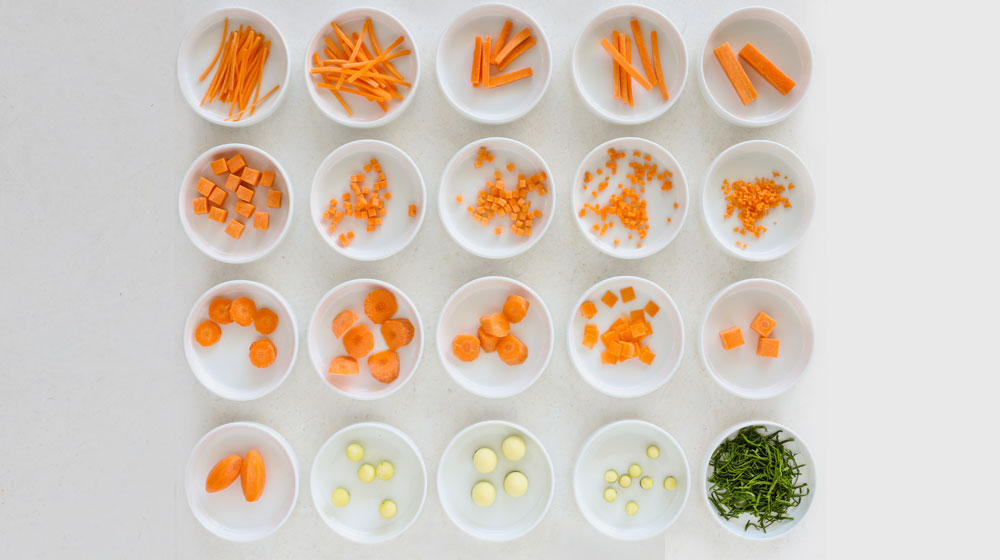Knowing how to do basic cuts can enhance your overall performance in the kitchen. It improves your prepping speed, as you don’t have to do too much thinking and envisioning before pushing your knife down.
When the materials are cut properly, they’re more likely to be cooked evenly to the desired degree of doneness. Uniformity in the shape and size of the veggies also makes the dishes much more aesthetically desirable – in other words, cutting your product EVENLY makes it look like a culinary professional is working in the kitchen (rather than a near-sighted beagle, gnawing on carrots with it’s three remaining teeth).
Don’t be a beagle.
Here’s a table of the basic culinary cuts you should know
| Measurements | Strip | Dice |
| 3/4 in x 3/4 in x 3/4 in | Carré (Large Dice) | |
| 1/2 in x 1/2 in x 1/2 in | Parmentier (Medium Dice) | |
1/4 in x 1/4 in x 2-2.5 in | Bâtonnet | Macédoine (Small Dice) |
| 1/8 in × 1/8 in × 2 in | Julienne | Brunoise |
| 1/16 in × 1/16 in × 2 in | Fine Julienne | Fine Brunoise |
| 1/2 in x 1/2 in x 1/8 in | Paysanne (Square) | |
| 1/8 in | Chiffonade |
Strip Cuts

Batonnet
Bâtonnet, pronounced bah-tow-nay, is a French word that means “little sticks”. And that’s exactly what you’re supposed to produce – the Batonnet refers to cuts of 1/4 inch x 1/4 inch x 2-2.5 inches (6mm x 6mm x 5–6 cm) batons. This is one of the most basic cuts in French cuisine.

Steps to perform the basic Batonnet cut:
- Get a knife, preferably a sharp chef’s knife.
- Remove both ends of the object you’re batonneting, be it a carrot, a cucumber, or a beetroot. Cut it into 2 inches long portions.
- Cut the sides of each portion until it becomes a rectangular shape.
- Cut those pieces into 1/4 inch slabs.
- Cut the slabs lengthwise into 1/4 inch strips.

Julienne (or Allumette if it’s a potato)
The measurement for julienne (pronounced joo-lee-en) is 1/8 inch × 1/8 inch × 2 inches (3mm × 3mm × 5 cm). The Julienne can be achieved by cutting the Batonnet lengthwise into 4 equal square sticks, and then into 2 crosswise. Julienne a potato? You just made Allumettes. Same cut, different name.
JARDINIERE
Similar in shape to julienne, a jardiniere cut is slightly bigger, however, roughly 1/6 inch x 1/6 inch by 3 inches (although, they can be slightly longer). Think: matchstick french fries from Steak and Shake.

Fine Julienne
Measured 1/16 inch × 1/16 inch × 2 inches (1.5mm x 1.5mm x 5cm), the fine julienne can be make by cutting a normal julienne into 4 equal sticks lengthwise. But of course it’d be easier to make it from thin slabs rather than sticks.
Cube cuts

Carré (Large dice)
This cut features cubes with 6 even sides measuring approximately ¾ inch (2 cm).

How to do the Carre cut properly:
- Perform topping and tailing on the object (carrot/potato/ect). Cut the sides so it becomes a rectangular shape.
- Cut it into slabs measuring ¾ inch in thickness.
- Cut the slabs lengthwise so they become sticks measuring ¾ inch x ¾ inch in depth and width.
- Cut the sticks into ¾ inch x ¾ inch¾ inch cubes.
Parmentier (Medium dice) and Macédoine (Small dice)

These cubes measure approximately ½ inch x ½ inch x ½ inch (1.25 cm each).
The Parmentier can be made in the same way as the Carré, except with smaller measurements.
The measurements for the Macedoine (small dice) is ¼ inch (6mm) x ¼ inch x ¼ inch. Cube the Batonnet and you’ll get this cut.
Brunoise and Fine Brunoise

The brunoise is tiny little cubes measuring 1/8 inch (3mm). They can be made from the Julienne in a similar way to getting small dice from the batonnet.
The fine brunoise is 1/16 inch (1.5mm) for width, depth, and length alike. Do the Fine Julienne, and cut the sticks into these little cubes. You will need a thin and extremely sharp chef’s knife to do this cut!
Other cuts

Paysanne and Rondelle

Cutting a vegetable paysanne-style is to slice it thinly, but according to its natural shape, without squaring it off. For example, a carrot may be cut en paysanne into thin circles that have differing diameters. The Paysanne is typically considered a more informal French cut. Basically, you cut the veggies/fruits/roots with a measurement of about 1/2 inch x 1/2 inch x 1/8 inch. However, some call squares of vegetable cut to the same size Paysannes as well, making things confusing.
Rondelles and Bias Cuts

Rondelles are simply paysanne cuts made from round vegetables. Bias cuts are rondelles sliced at an angle to the vegetable, creating long ovals.
Obliques/ Roll Cuts

Both obliques and roll-cut vegetables are cut on the bias to create greater cooking surface for caramelization to occur or to improve the look of the product on the plate.
Chiffonade
This is a technique with which you cut herbs or leaves into long, thin strips (ribbons).

- Gather the leaves or herbs into a stack. Put larger ones at the bottom and smaller ones on top. You can have about 8 to 10 small leaves (basil, catnip, lemon balm, ect) or 3 to 4 large leaves (lettuce) at a time.
- If the leaves are large enough, roll them into a cigar shape.
- Slice the roll into thin strips of about ⅛ inch (.3 cm) in width.
